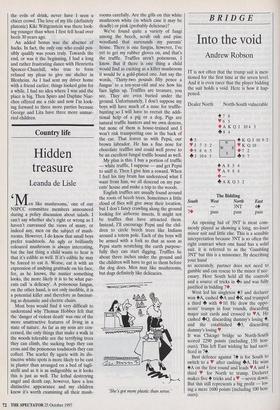Country life
Hidden treasure
Leanda de Lisle
cm en like mushrooms,' one of our NSPCC committee members announced during a policy discussion about salads. I can't say whether she's right or wrong as I haven't canvassed the views of many, or indeed any, men on the subject of mush- rooms. However, I do know that small boys prefer toadstools. An ugly or brilliantly coloured mushroom is always interesting, but the last thing a child wants to hear is that it's edible as well. If it's edible he may be forced to eat it. Worse, eat it with an expression of undying gratitude on his face, for, as he knows, the nastier something looks, the more likely it is to be what par- ents call 'a delicacy'. A poisonous fungus, on the other hand, is not only inedible, it is a potential killer and therefore as fascinat- ing as dynamite and electric chairs.
Most boys would find it very difficult to understand why Thomas Hobbes felt that the 'danger of violent death' was one of the more unattractive features of living in a state of nature. As far as my sons are con- cerned, the only things that make a walk in the woods tolerable are the terrifying trees they can climb, the sucking bogs they can cross and the poisonous toadstools they can collect. The scarlet fly agaric with its dis- tinctive white spots is more likely to be cast in plaster than arranged on a bed of tagli- atelli and as it is as indigestible as it looks this is just as well. The lethal destroying angel and death cap, however, have a less distinctive appearance and my children know it's worth examining all their mush- rooms carefully. Are the gills on this white mushroom white (in which case it may be deadly) or pink (probably delicious)?
We've found quite a variety of fungi among the beech, scrub oak and pine woodland that surrounds my parents' house. There is one fungus, however, I've yet to get my rubber gloves on, and that's the truffle. Truffles aren't poisonous, I know. But if there is one thing a child would find as exciting as a killer mushroom it would be a gold-plated one. Just say the words, 'Thirty-two pounds fifty pence a fungus' to a ten-year-old and see how his face lights up. Truffles are treasure, you see. They are even buried under the ground. Unfortunately, I don't suppose my boys will have much of a nose for truffle- hunting so I will have to recruit the addi- tional help of a pig or a dog. Pigs are natural truffle hunters and we own dozens, but none of them is house-trained and I won't risk transporting one in the back of the car. That leaves us with Pepsi, our brown labrador. He has a fine nose for chocolate truffles and could well prove to be an excellent fungal truffle hound as well.
My plan is this. I buy a portion of truffle — white truffle, I suppose — and get Pepsi to sniff it. Then I give him a reward. When I feel his tiny brain has understood what I want from him, we all descend on my par- ents' house and make a trip to the woods.
English truffles are usually found around the roots of beech trees. Sometimes a little cloud of flies will give away their location, but I don't fancy crawling along the ground looking for airborne insects. It might not be truffles that have attracted them. Instead, I'll encourage Pepsi and the chil- dren to circle beech trees like Indians around a totem pole. Each of the boys will be armed with a fork so that as soon as Pepsi starts scratching the earth purpose- fully they can start digging. Truffles lie about three inches under the ground and the children will have to get to them before the dog does. Men may like mushrooms, but dogs definitely like delicacies.
`She's got more plastic than sense.'


















































































 Previous page
Previous page